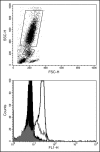Hypoxia mediated release of endothelial microparticles and increased association of S100A12 with circulating neutrophils
- PMID: 20046638
- PMCID: PMC2763224
- DOI: 10.4161/oxim.2.1.7611
Hypoxia mediated release of endothelial microparticles and increased association of S100A12 with circulating neutrophils
Abstract
Microparticles are released from the endothelium under normal homeostatic conditions and have been shown elevated in disease states, most notably those characterised by endothelial dysfunction. The endothelium is sensitive to oxidative stress/status and vascular cell adhesion molecule-1 (VCAM-1) expression is upregulated upon activated endothelium, furthermore the presence of VCAM-1 on microparticles is known. S100A12, a calcium binding protein part of the S100 family, is shown to be present on circulating leukocytes and is thought a sensitive marker to local inflammatory process, which may be driven by oxidative stress. Eight healthy males were subjected to breathing hypoxic air (15% O(2), approximately equivalent to 3000 metres altitude) for 80 minutes in a temperature controlled laboratory and venous blood samples were processed immediately for VCAM-1 microparticles (VCAM-1 MP) and S100A12 association with leukocytes by flow cytometry. A pre-hypoxic blood sample was used for comparison. Both VCAM-1 MP and S100A12 association with neutrophils were significantly elevated post hypoxic breathing later declining to levels observed in the pre-test samples. A similar trend was observed in both cases and a correlation may exist between these two markers in response to hypoxia. These data offer evidence using novel markers of endothelial and circulating blood responses to hypoxia.
Keywords: RAGE; S100A12; VCAM-1; endothelium; hypoxia; microparticles; oxidative stress.
Figures



Similar articles
-
Release of VCAM-1 associated endothelial microparticles following simulated SCUBA dives.Eur J Appl Physiol. 2009 Mar;105(4):507-13. doi: 10.1007/s00421-008-0927-z. Epub 2008 Nov 12. Eur J Appl Physiol. 2009. PMID: 19002703
-
Oscillatory shear stress, flow-mediated dilatation, and circulating microparticles at sea level and high altitude.Atherosclerosis. 2017 Jan;256:115-122. doi: 10.1016/j.atherosclerosis.2016.12.004. Epub 2016 Dec 2. Atherosclerosis. 2017. PMID: 28010936 Clinical Trial.
-
Significance of neutrophil microparticles in ischaemia-reperfusion: Pro-inflammatory effectors of endothelial senescence and vascular dysfunction.J Cell Mol Med. 2020 Jul;24(13):7266-7281. doi: 10.1111/jcmm.15289. Epub 2020 Jun 10. J Cell Mol Med. 2020. PMID: 32520423 Free PMC article.
-
Human S100A12: a novel key player in inflammation?Amino Acids. 2009 Mar;36(3):381-9. doi: 10.1007/s00726-008-0097-7. Epub 2008 Apr 29. Amino Acids. 2009. PMID: 18443896 Review.
-
S100 proteins in atherosclerosis.Clin Chim Acta. 2020 Mar;502:293-304. doi: 10.1016/j.cca.2019.11.019. Epub 2019 Nov 30. Clin Chim Acta. 2020. PMID: 31794767 Review.
Cited by
-
Circulating Endothelial Microparticles: A Key Hallmark of Atherosclerosis Progression.Scientifica (Cairo). 2016;2016:8514056. doi: 10.1155/2016/8514056. Epub 2016 Mar 15. Scientifica (Cairo). 2016. PMID: 27066292 Free PMC article. Review.
-
S100A12 as a marker of worse cardiac output and mortality in pulmonary hypertension.Respirology. 2018 Aug;23(8):771-779. doi: 10.1111/resp.13302. Epub 2018 Apr 2. Respirology. 2018. PMID: 29611244 Free PMC article.
-
Circulating Microparticles Are Differentially Increased in Lowlanders and Highlanders with High Altitude Induced Pulmonary Hypertension during the Cold Season.Cells. 2022 Sep 20;11(19):2932. doi: 10.3390/cells11192932. Cells. 2022. PMID: 36230894 Free PMC article.
-
The genesis of cardiovascular risk in inflammatory arthritis: insights into glycocalyx shedding, endothelial dysfunction, and atherosclerosis initiation.Clin Rheumatol. 2023 Oct;42(10):2541-2555. doi: 10.1007/s10067-023-06738-x. Epub 2023 Aug 15. Clin Rheumatol. 2023. PMID: 37581758 Review.
-
Carbon monoxide inhalation increases microparticles causing vascular and CNS dysfunction.Toxicol Appl Pharmacol. 2013 Dec 1;273(2):410-7. doi: 10.1016/j.taap.2013.09.019. Epub 2013 Sep 30. Toxicol Appl Pharmacol. 2013. PMID: 24090814 Free PMC article.
References
-
- Schmid-Schonbein GW, Engler RL. Granulocytes as active participants in acute myocardial ischemia and infarction. Am J Cardiovasc Pathol. 1987;1:15–30. - PubMed
-
- Inauen W, Granger DN, Meininger CJ, Schelling ME, Granger HJ, Kvietys PR. Anoxia-reoxygenation-induced, neutrophil-mediated endothelial cell injury: Role of elastase. Am J Physiol. 1990;259:925–931. - PubMed
-
- Semenza GL. Cellular and molecular dissection of reperfusion injury: ROS within and without. Circ Res. 2000;86:117–118. - PubMed
-
- Freyssinet JM. Cellular microparticles: What are they bad or good for? J Thromb Haem. 2003;1:1655–1662. - PubMed
-
- Horstman LL, Jy W, Jimenez JJ, Ahn YS. Endothelial microparticles as markers of endothelial dysfunction. Front Biosci. 2004;9:1118–1135. - PubMed
Publication types
MeSH terms
Substances
LinkOut - more resources
Full Text Sources
Research Materials
Miscellaneous

